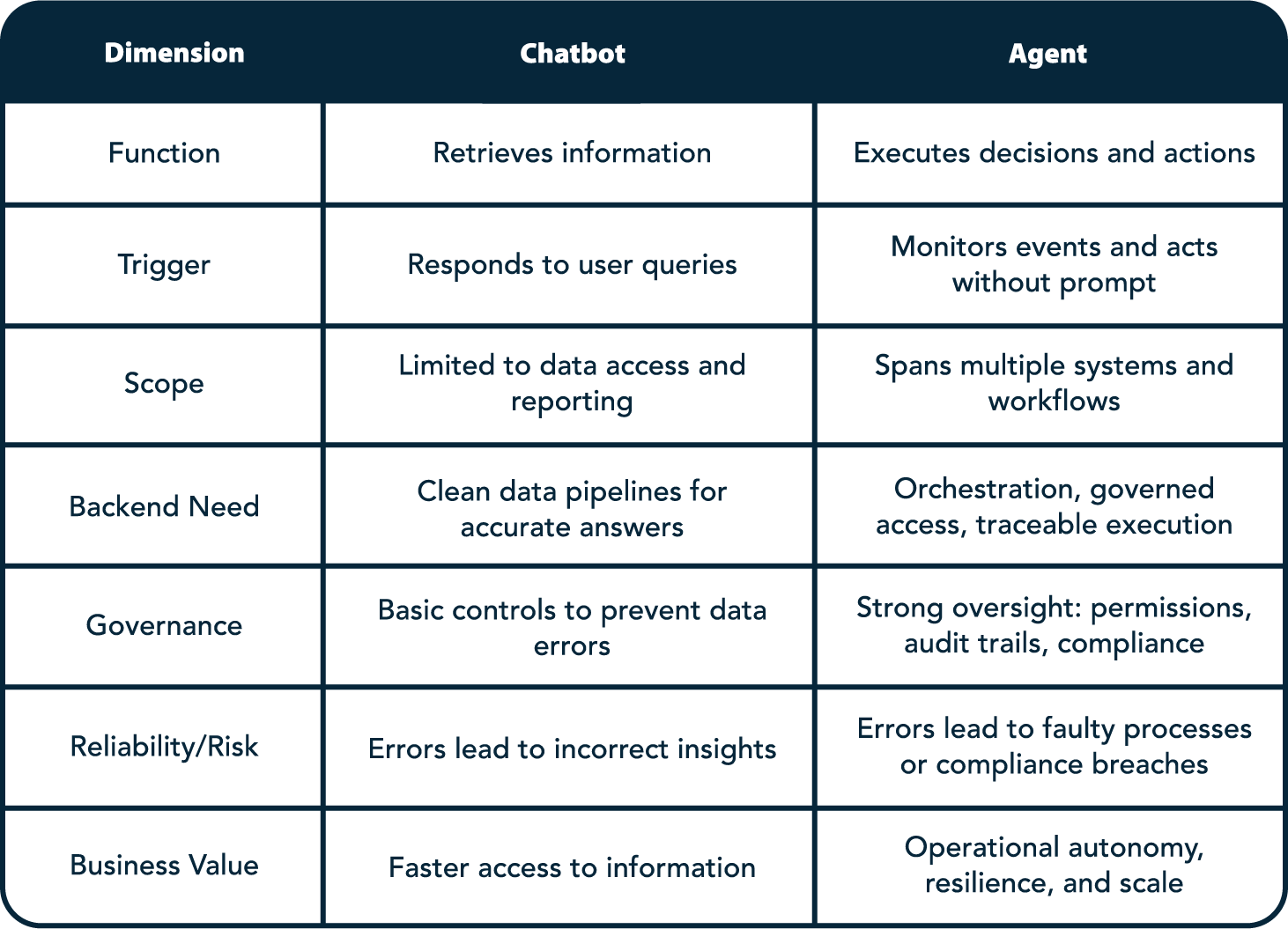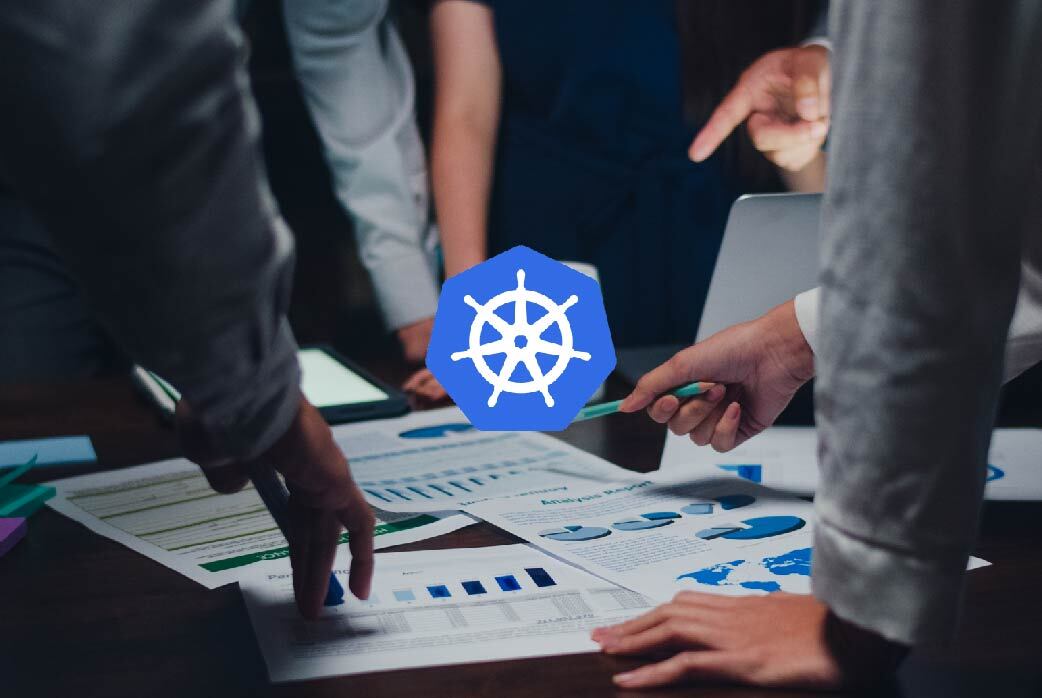
Chatbots provided enterprises with an accessible way to interact with data, but their accuracy and usefulness have always depended on the quality of the backend that feeds them.
Agents extend this logic. They surface numbers on request and act on them. Detecting sales anomalies, updating CRM records, or flagging financial risks is only possible if the underlying systems are structured, reliable, and connected.
A chatbot fails when data pipelines are fragmented or when the entire backend (data, orchestration, security, and governance) isn’t prepared. The strategic question for enterprises is whether their backend can support this next level of autonomy.
From Chatbot to Agent: How to Catch the Difference
Chatbots simplify access to information but remain reactive. They can only deliver what is asked, when it is asked, and nothing more. Consider a supply chain manager checking inventory. A chatbot can answer, “What is the current stock level in the warehouse?” and return the figure instantly. The exchange ends once the number is displayed.
An agent, by contrast, detects when stock falls below a threshold, compares it against forecasted demand, and automatically issues a replenishment order through the ERP system. One system provides answers, the other initiates outcomes.
The backend moves from supporting questions to supporting operations, which in practice means the need to build a more mature foundation capable of unifying data, coordinating workflows, and sustaining reliable autonomous actions.

Case Scenarios: Chatbot vs. Agent
Scenario 1
- Chatbot: A manager asks, “What were Q2 sales?” → Response: “$12.3M with a chart.”
- Agent: Detects sales decline vs. forecast, runs cohort analysis, drafts corrective pricing strategies, and prepares a report for leadership.
Scenario 2
- Chatbot: Answers FAQs from customers using knowledge base content.
- Agent: Monitors service queue volumes, reprioritizes tickets, escalates VIP issues to human agents, and triggers a proactive discount campaign in CRM.
Scenario 3
- Chatbot: Tells the CFO the current expense totals.
- Agent: Flags anomalies in expense claims, freezes suspicious accounts, and auto-generates compliance documentation.
Data Foundations Matter for Both
Chatbots and AI agents cannot operate without a solid data foundation. Let's consider three elements.
- First, pipelines: if data is late or inconsistent, agents act on the wrong inputs.
- Second, scope: systems must integrate transcripts, feedback, and documents into a single layer.
- Third, metadata: without clarity on ownership, KPI definitions, and data lineage, outputs vary from team to team.
Each gap creates errors that scale quickly once agents begin to act. 42 % of enterprises report that over half of their AI projects fail or underdeliver due to data issues.
Why Data Readiness Only Is Not Enough
Structured, reliable data is the minimum requirement for agents, but it does not make them operational.
A chatbot can return correct figures as long as the warehouse is unified and clean. An agent, however, is expected to act on those figures: launch a workflow, update a system of record, or escalate an anomaly. These steps depend on the environment where the agent executes.
Data readiness alone cannot sustain autonomous processes. Agents need a backend with orchestration, controlled system access, and traceable execution. Without these layers, the system may deliver insights but will fail once action is required. Most stalled initiatives reflect this gap: the backend was built for reporting, not for autonomous operations.
What Changes in the Backend: Key Shifts
Enterprises need to embrace four key shifts within their information systems to position themselves for the agentic era.
From Data Access to Orchestration
For chatbots, a single, unified warehouse is usually enough, as it delivers consistent answers to straightforward questions. Agents, however, need more than access. They must connect data to business processes, respond to events as they happen, and maintain context over time. It requires an orchestration layer that ties together data, workflows, and APIs. The backend moves from “store and answer” to “monitor and execute.”
From Data Security to Operational Governance
With chatbots, the main concern was preventing data leakage. With agents, the risks extend to actions. They need scoped permissions, logging of every autonomous step, and compliance controls aligned with ISO, SOC, HIPAA, and GDPR. An over-permissioned agent can update invoices, move funds, or alter records without oversight. Security and sovereignty are no longer guardrails around the system — they are design principles built into its core.
From Snapshots to Real-Time Context
Chatbots can tolerate periodic updates. Agents cannot. They require live telemetry from applications, IoT devices, and customer interactions to act in context. It raises the bar for integration:
- APIs must be robust
- Event streams standardized
- Latency reduced to milliseconds
Backend design becomes integration-first because every delay or gap in data translates into a flawed decision or action.
From Output Accuracy to System Reliability
If a chatbot returns a wrong figure, the damage is limited to a poor decision by a user. An agent that misfires can disrupt operations, breach compliance, or cause financial loss. Reliability, therefore, becomes measurable: redundancy, failover, guardrails on high-risk actions, and human checkpoints for sensitive processes.
Key Takeaways
- Many enterprises have adapted their systems for AI chatbots and assume this foundation is sufficient for AI agents. It is not.
- Chatbots answer, while AI agents act. One provides information, the other executes workflows and decisions.
- Clean, unified data is critical for both. For chatbots, it is often enough. For agents, it is only the starting point.
- To support agents, enterprises need orchestration layers to connect data with processes; governance and security to manage permissions, enforce compliance, and ensure traceability; and reliability mechanisms to protect operations.
- If you want to deploy Agentic AI, backend transformation and maturity must come first. The technology works only in an environment that is structured, integrated, and governed.







